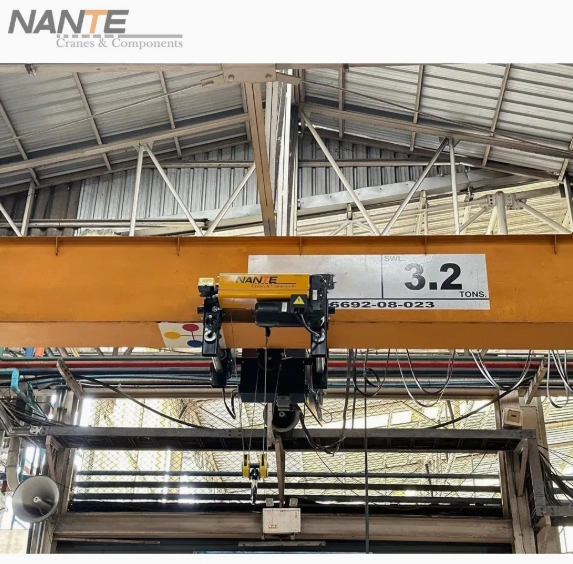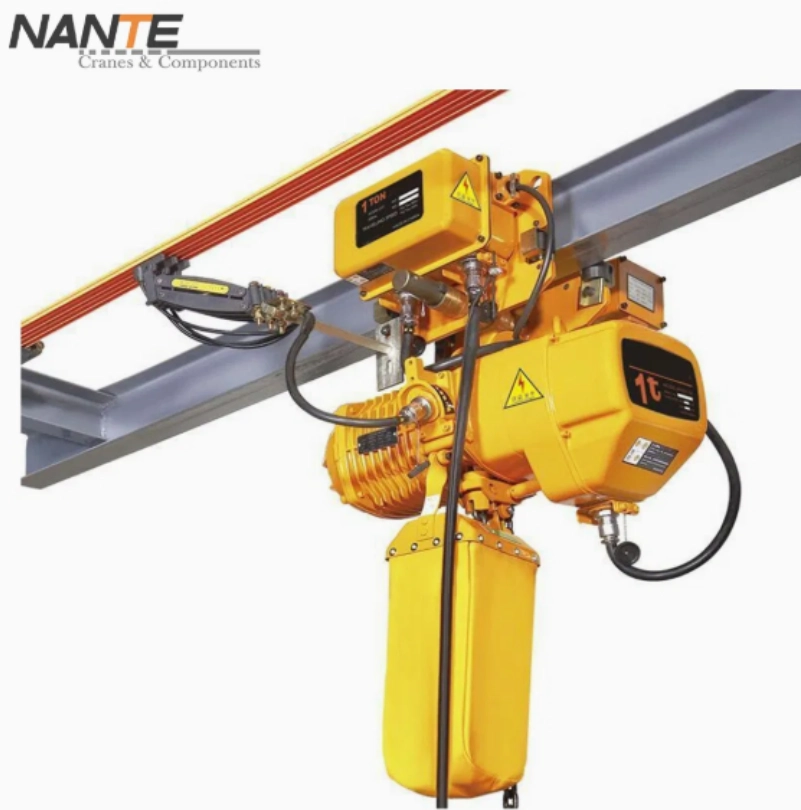How to Choose Between a Wire Rope Hoist and a Chain Hoist for Crane Applications
How to Choose Between a Wire Rope Hoist and a Chain Hoist for Crane Applications
Date: 2025-10-02 Share:
Introduction to Wire Rope Hoists and Chain Hoists in Crane Systems
Hoisting systems are the core of today’s cranes. They lift heavy items safely and fast in places like workshops, building areas, and storage sheds. Two main kinds are out there: wire rope hoists, which use strong steel cables twisted around a drum, and chain hoists, which use connected metal chains pulled by pocket wheels. These hoists join with cranes like overhead, gantry, and bridge cranes. Each is made for special tasks. Picking the right hoist is a huge deal. It shapes how well the crane works, keeps folks safe, and handles costs.
Wire Rope Hoists for Crane Applications
Definition and Basic Components of Wire Rope Hoists
Wire rope hoists are tough setups built for heavy lifting in cranes. They come with a motor, gearbox, brakes, a drum, pulleys, hooks, and safety tools like overload switches and phase relays. They latch onto crane trolleys to glide side to side along crane beams. With capacities from 1 ton to 300 tons, wire rope hoists suit many crane types.
Key Advantages of Wire Rope Hoists in Heavy-Duty Crane Operations
Wire rope hoists are super for big crane jobs. They can lift up to 300 tons with almost no cable stretch. This keeps loads steady. They zip along at up to 65 feet per minute, great for busy places. Their solid cables and variable frequency drives (VFDs) give pinpoint control. This makes them perfect for tough tasks in cranes at shipyards or steel mills.
Potential Disadvantages of Wire Rope Hoists for Specific Crane Setups
Wire rope hoists have some flaws. They can wiggle sideways, so you need careful crane setup. Their big drum and pulley systems take up more room. This makes them less ideal for tiny or hand-pushed cranes. Also, wire ropes need regular checks to avoid wear. This can mean extra work for some crane jobs.
Chain Hoists for Crane Applications
Definition and Basic Components of Chain Hoists
Chain hoists are small lifting setups. They use metal chains stored in a chain bag, moved by pocket wheels. They have a motor, disc brakes, limit switches, and chain guides. Made for crane trolleys, they lift loads from 250 kg to 25 tons. They’re great for smaller or exact crane tasks.
Key Advantages of Chain Hoists in Versatile Crane Environments
Chain hoists are fantastic for careful crane work, like in assembly lines or storage sheds. Their small size fits tight spots. They manage side pulls well, making them ideal for gantry or jib cranes. Chain hoists cost 20-40% less to buy than wire rope hoists. They work nicely in clean places, like food processing or medicine-making plants.
Potential Disadvantages of Chain Hoists in Demanding Crane Conditions
Chain hoists have trouble in rough crane settings. Dust can mess up chain performance, so they need frequent cleaning. Their lifting speeds, from 5 to 32 feet per minute, are slower than wire rope hoists. This limits them in fast crane jobs. They also make more noise and can’t lift as much. This makes them less suited for heavy crane lifts.
Key Differences Between Wire Rope Hoists and Chain Hoists for Cranes
Load Capacity and Duty Cycle Comparisons in Crane Systems
Wire rope hoists lift up to 63 tons in standard setups (300 tons for open winch cranes). They’re rated for Class F duty cycles, perfect for nonstop heavy crane work, like shipyard lifts. Chain hoists top out at 25 tons with Class D ratings. They’re better for lighter, on-and-off crane tasks in workshops or storage sheds.
Lifting Speed, Height, and Precision Factors in Crane Lifts
Chain hoists give straight-up lifts up to 20 meters. They’re awesome for exact jobs, like car assembly. Wire rope hoists lift faster but have set height limits. They’re better for moving big items in cranes. For small tweaks, pick chain hoists. For quick, heavy lifts, choose wire rope.
Durability, Maintenance, and Environmental Suitability for Crane Deployments
Wire rope hoists are strong in tough conditions, from -40°C to 200°C. They hold up against weather and rust, making them great for outdoor crane jobs, like building sites. Chain hoists work best indoors, where dust and moisture are low. Wire ropes need checks twice a year. Chains need monthly oiling and cleaning.
Cost Analysis: Initial Investment Versus Long-Term Crane Ownership Costs
Chain hoists are 20-40% cheaper to buy, which is nice for budget crane projects. But wire rope hoists save money over time in heavy crane work. They last longer and need less frequent care. This makes them a smart pick for busy crane tasks.
Real-World Applications: Wire Rope Hoists Versus Chain Hoists in Crane Scenarios
Wire Rope Hoists in Heavy Industrial Crane Uses Like Steel Mills and Construction Sites
Wire rope hoists are key in big industrial crane jobs. In steel mills, they lift 50-ton ladles with care and safety. On building sites, they move beams on gantry cranes. Explosion-proof models keep things safe in risky crane zones, like chemical plants.
Chain Hoists in Precision Manufacturing and Warehouse Crane Operations
Chain hoists are perfect for careful crane tasks. They line up engines in car workshops or stack pallets in warehouse monorail cranes. Stainless steel models keep things clean in food processing crane setups.
Hybrid Approaches: Combining Hoist Types in Multi-Crane Facility Setups
In big places like distribution centers, mixed crane setups use wire rope hoists for large material loads and chain hoists for tiny tweaks during assembly or packing. This speeds up work across different crane jobs.
How to Choose the Right Hoist for Specific Crane Requirements
Assessing Load Weight, Frequency, and Crane Environment Needs
Pick wire rope hoists for loads over 5 tons or high-use crane cycles (more than 500 per day), like in steel production. Choose chain hoists for exact tasks under 5 tons in controlled spots, like warehouses. Think about humidity and temperature, too.
Evaluating Space Constraints and Installation Compatibility with Cranes
Chain hoists need less than 1 meter of space, fitting small crane setups. Wire rope hoists need 1.5 meters for their drum systems, so they require bigger crane structures. Make sure the trolley matches the crane beams for smooth use.
Considering Speed, Safety Features, and Regulatory Compliance in Crane Selection
Wire rope hoists offer different speeds for fast crane lifts. Chain hoists focus on being exact. Both have safety tools like overload protection and slack prevention. FEM/ISO certifications make sure they follow crane rules.
Budgeting for Total Cost of Ownership in Long-Term Crane Projects
Think about starting costs, energy use, and warranties. Wire rope hoists can save 15% in big crane projects. Chain hoists are better for tight budgets with lower upfront costs.
Nante Crane: Leading Provider of Crane Components and Hoisting Solutions
Company Profile and Global Commitment to Crane Innovation
Nante Crane is a top name in crane parts, known for great engineering and ISO 9001/CE certifications. They serve industries like cars and energy, offering trusty hoisting solutions for crane jobs worldwide.
Overview of Nante Crane’s Hoisting Mechanism Product Lineup
Nante Crane offers wire rope hoists like NHA (1.6t-63t), NHC (1.6t-16t), CDMD (1t-20t), and NHA-EX (2t-20t) for risky crane settings, plus open winches (NW, 5t-300t). Their chain hoists include NCHA (250kg-5t) and NCHC (250kg-25t), meeting various crane needs.
Contact Nante Crane for free advice and quotes to improve your crane operations today.
FAQ: Common Questions on Wire Rope Hoists and Chain Hoists for Cranes
What Is the Maximum Capacity for a Wire Rope Hoist in Crane Applications?
Up to 300 tons for open winch cranes.
When Should Facilities Choose Chain Hoists Over Wire Rope Hoists for Cranes?
Pick chain hoists for precise tasks under 5 tons, like in assembly lines.
How Do Maintenance Requirements Differ Between Wire Rope and Chain Hoists?
Wire ropes need checks twice a year. Chains need monthly oiling.
Can Nante Crane Hoists Be Customized for Specific Crane Environments?
Yes, Nante Crane offers explosion-proof and variable-speed options for specific crane needs.
What Safety Features Are Standard in Nante Crane’s Hoisting Mechanisms?
Overload switches, phase relays, and emergency brakes keep crane operations safe.





